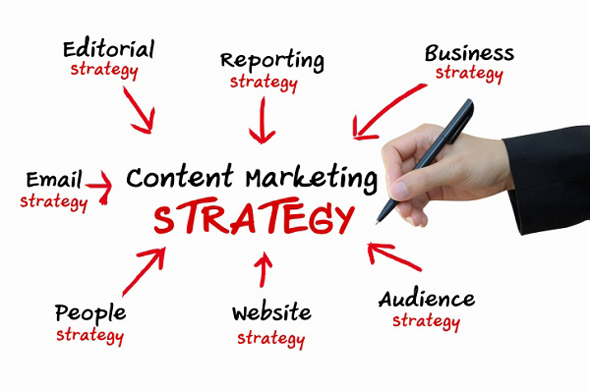Six Steps to Define a Content Marketing Strategy
Are You Ahead or Behind the Curve?
Looking ahead to 2015 and beyond, brands that are going to find greater successful with their ongoing digital marketing efforts will be the ones who have a strategic vision and plan for implementing content marketing. If you are not already experimenting with processes and workflow, performing tests and trials, documenting best practices, and quantifying results, you are already behind the curve.
Content marketing promises to be a preferred content distribution model to better engage and influence target audiences at every step in the consumer journey. It is not an isolated tactic reserved for a single piece of content or campaign; rather it should be viewed as a critical and sustaining component within your overall content strategy and integrated digital marketing effort.
As consumer fatigue and information overload continues to escalate, studies have shown connected consumers today are tuning out much more frequently and glazing over brand marketing using an instant gratification filter. In increasing numbers, consumers are demonstrating they have little patience with brands who do not deliver valuable, relevant and consistent content to meet their needs.
According to recent findings from the CMO Council, as much as 90% of consumers now find custom content useful and 78% believe that organizations providing custom content are interested in building good relationships with them.
The impact has been significant. Aging one-to-many and static content delivery models are no longer seen as effective, which has forced many organizations to rethink the role of content relative to consumer influence.
For many organizations, content marketing offers a better strategic direction. Delivering dynamic content aligns to changing consumer consumption habits with the benefit of creating greater brand relevancy for attracting new customers and reinforcing existing relationships through enhanced brand experiences.
In the years ahead, companies who are successful with delivering content with higher degrees of consumer relevancy and value will be in a much better position to build and reinforce customer relationships; brands that do not will risk obsolescence.
Building a Strategy
As with all marketing efforts, strategy should come before tactics. Content marketing is no exception. Where many companies fall short with content marketing is typically “a leap first and look later” approach without applying enough strategic foresight to clearly understand why they need it, who they need to target, and how they will benefit. Unfortunately, more times than not this leads to the effort being considered ineffective over a short period of time even before the initiative really gets started.
Content marketing requires a purpose and a target to be successful. It also requires a clear vision for how it will be executed and a business case for internal stakeholders so that organizations can adequately apply sufficient resources and budgets to make a proper commitment and investment.
So where should you start? If you are considering implementing a content marketing strategy, before you produce a single piece of content you may want to consider the following steps to define a strategic plan. The amount of investment you make in this planning process will be a major determinant for the level of success you may realize.
- Purpose & Objectives
Content marketing requires a purpose.
Begin with defining your objectives mapped to your organizational needs based on your current situation. Do you have a need for lift in brand awareness, website traffic, consumer engagements, lead generation, customer loyalty, or conversions? Do your SEO rankings need to improve with more inbound links? Or, maybe would it be helpful to be considered as an industry thought leader?
Objectives can be as unique as the organization itself. A review of your digital marketing efforts measured against underlying business and marketing goals will help you align real-time performance needs to your objectives.
- Target Audiences
Once you have some clear objectives defined, the next step should be to define who will benefit.
If you haven’t already done so, you will need to contextually profile your target audiences with an emphasis placed on needs and interests. Apply as many filters as possible to categorize audiences into groups using broad segmentation, micro-targeting and personalization techniques.
Start by using a broad segmentation filter and work backwards to refine the categories into more specific consumer profile groups based on deeper levels of personalized needs and interests. As your target audiences begin to take shape and their characteristics become more evident, you will be able to better determine what types of branded content may best influence and resonate with your audiences.
- The User Experience
Based on the target profiles created, the added step of wire framing the user experience will help you understand distribution priorities for your content marketing efforts. This process should analyze all digital touch points where dynamic content delivery makes sense and where it should be applied.
The analysis should also identify how the content should be developed and delivered at each stage of the consumer journey and at each touch point using broad segmentation, micro-targeting or personalization filters.
The questions you should seek to answer as part of mapping the user experience for your content marketing initiative should include:
- Where does it offer value in the consumer journey?
- How can it be applied for each target profile?
- Where can better brand experiences be created?
- How should it be delivered at each touch point?
- And, where can the effort be scaled and leveraged?
- Content Needs
Once you have a better understanding of your objectives, target audiences and the user experience, you can now think about the content.
The objective should be to distribute a steady stream of fresh, consistent content to targeted audiences across all digital touch points that will shape consumer opinions and influence consumer actions to impact business goals.
This will require developing a deep understanding of what type of content will appeal and resonate with each of your target audience profiles. To understand your content needs, outline your proposed content and editorial directions along with channel use, content type and the anticipated volume needed to sustain a consistent effort and mapped to the user experience.
As this work comes together, your editorial directions can seek to inform, teach, inspire, entertain, or persuade. Individual pieces of content can take the form of articles, blog posts, infographics, e-newsletters, videos, cartoon drawings, animations, tutorials, podcasts, presentations and more.
The key to content marketing is to deliver relevance and perceived value. There will always be a fine line for what is perceived as relevant and valued. Many times it will come down to individual views and personal opinions, where one person may consider a single piece of content as simply promotional, and another person may see it with intrinsic value based on personal interests.
However, the overriding goal should be to provide as much value as possible whenever content is delivered to influence the largest number of people within the target audience it was intended. Your content and editorial directions should reflect this.
- Content Acquisition
Branded content isn’t always original content. Content itself can be developed or acquired through three primary means. Obviously, original “owned” content is the core component in a content marketing strategy and is essential to the overall effort.
However, to provide economies of scale for balancing resources and costs, curation and aggregation techniques are often used to supplement original content. Both approaches can be used to support the overall brand effort with top-of-funnel engagements to attract and appeal to larger audiences who may not be current customers.
It should be pointed out that content curation and content aggregation is not the same thing. Curation is actually a subset of aggregation. Whereas, content curation adds commentary and unique insights to third party content, aggregation does not.
- Content curation adds commentary and opinions to third party content to provide unique insights to establish a thought leadership position in a specific niche.
- Content aggregation supplements the content strategy by sourcing, cataloging and publishing third party content without commentary or added insights to provide more information on a specific business niche or topic.
Both content curation and content aggregation are strategic elements of content marketing. When done correctly, they create a powerful digital experience, providing valuable content to users while still expressing a brand’s core values.
Organizations routinely leverage all three components as a comprehensive publishing platform. Whether content used in the content marketing effort is original, curated or aggregated, you will need to decide based on your own internal resources and needs, how best to balance the approach to sustain your overall effort.
- Resource Allocation
One of the last major considerations in the strategic planning process and for making a business case may be the most difficult. From the insights gathered up to this point, you will need to review the required investments in staff, resources and budgets. Based on the proposed levels for organizational adoption, the following questions should be answered.
- What impact will this have on your current infrastructure?
- Will you need to add skill sets, headcount, or a dedicated team?
- Will you need outside vendor assistance?
- Will the effort require specialized tools and systems?
- Will your current budget support the overall forecasted expense?
As you consider these final questions to determine whether there’s a business case for implementing content marketing, keep in mind content marketing is not a one-fit-all concept. The level of commitment and the approaches applied can vary based on individual organizational needs.
Moving From Strategy to Execution
Once you have a strategic direction in place supporting a business case to proceed, you can use the framework to begin putting systems in place and building a team. Once implementation starts, your content marketing effort should evolve through experimentation with processes and workflow, performing tests and trials, documenting best practices, and quantifying results.
If you stay the course and follow your vision, best practices and execution efficiencies will be developed over time, which ultimately will lead to greater influence with your target audiences.
More and more organizations are now adding content marketing in their marketing toolbox. The stage has been set for worldwide adoption and the discussion surrounding content marketing is not likely to abate any time soon.
Whether you choose to be ahead or behind the curve of adoption is your own decision. But there is one reality. Consumer fatigue and information overload is not a myth. It’s a fact. If your content doesn’t immediately address consumer’s needs, they will in increasing numbers quickly dismiss it and move on to something else.
——————-
What do you think? Is content marketing part of your marketing toolbox? What advice would you have for getting started? Please feel free to share your thoughts and recommendations in the comment section below.
DanielMcKean is a digital brand analyst for the Emakina Group and is based in Los Angeles, California. His focus is on helping companies align their digital ecosystems to business best practices and ROI. He has an impressive track record for delivering business results mapped to corporate goals and objectives for an assortment of global brands across a diverse range of industries.
Email: dmckean@emakina.ch
Twitter: @danielmckean
Our recent blog posts
See all blogs-
How is AI’s synthetic data enhancing User Experience Research? Technology

-
Web3.AI Rising : How new technology can add value to your business

-
How generative AI helped us create an e-commerce app – with personalised content – in just 2 weeks Technology

-
Can you build a foodie app in 3 days using Generative AI? (Spoiler alert: yes!)





